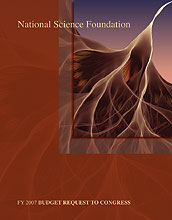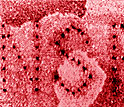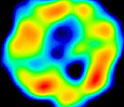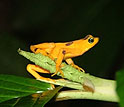News Release 06-022
Request for National Science Foundation Fiscal Year 2007 Is $6.02 Billion
Sum reflects agency's key role in American Competitiveness Initiative

The fiscal year 2007 budget to Congress requests $6.02 billion for NSF.
February 6, 2006
This material is available primarily for archival purposes. Telephone numbers or other contact information may be out of date; please see current contact information at media contacts.
The President's budget for fiscal year 2007 requests $6.02 billion for the National Science Foundation--an increase of $439 million or 7.9 percent over fiscal year 2006. The increase reflects a 10-year budget-doubling effort for NSF and other agencies as part of the American Competitiveness Initiative that President Bush announced in the State of the Union address last week.
"This is a great day for NSF, and that means it's a great day for the nation," said NSF Director Arden L. Bement, Jr., at a public presentation held at NSF's Arlington, Va., headquarters. "America's leadership depends more and more on the quality of our new ideas--the vitality of our science and engineering workforce--and the innovative use of new knowledge generated through research and education. With today's intense global competition for ideas and talent, for comparative advantage, and market opportunities worldwide, we must keep the momentum of leadership moving forward.
"The president's budget submission for NSF aims to do just that, and I am delighted to bring you the good news," Bement said.
The fiscal year 2007 request will allow NSF to make major contributions to new fundamental knowledge, and to underwrite discoveries that affect the future of science, engineering and education. In addition, through the foundation's long-standing practice of integrating research and education, the budget will facilitate the transfer of new concepts to the private sector as students involved in discovery enter the work force.
The fiscal year 2007 request for NSF's four broad funding categories is:
- $2.9 billion (up 6.1 percent) for discovery across the frontier of science and engineering, connected to learning, innovation and service to society
- $1.68 billion (up 13.2 percent) for broadly accessible, state-of-the-art science and engineering facilities, tools and other infrastructure that enable discovery, learning and innovation
- $1.07 billion (up 3.8 percent) for a diverse, competitive, and globally engaged U.S. workforce of scientists, engineers, technologists and well-prepared citizens
- $350 million (up 11.6 percent) for an agile, innovative organization that fulfills its mission through leadership in state-of-the-art business practices
In addition, the NSF portfolio emphasizes four priorities that will strengthen the science and engineering enterprise through investments in frontier research, the workforce, education and cutting-edge research tools.
ADVANCING THE FRONTIER
To engage the scientific and engineering communities in identifying the most promising directions and best researchers, NSF proposes to increase investments in research and related activities by $334 million or 7.7 percent. Among the highlights:
- The Cyber Trust and Cybersecurity investment includes $35 million (up $10 million from fiscal year 2006) for research to ensure computers and networks and underlying infrastructures can be relied on. Cyber Trust is part of the larger NSF Cybersecurity and Information Assurance research effort totaling $97 million for fiscal year 2007 (up 26 percent).
-
Key federal-wide investments include Networking and Information Technology Research and Development at $904 million (up $93 million); the National Nanotechnology Initiative at $373 million (up $29 million); and the Climate Change Science Program (at $205 million (up $8 million); and homeland security activities also increase by $42 million, to $384 million.
- The nanotechnology intitiative investment includes $65 million for Nanoscale Interdisciplinary Research Teams. These awards encourage team approaches to address nanoscale research and education themes that require a synergistic blend of expertise.
- NSF will invest $20 million in fundamental research on new technologies for sensors and sensor systems to improve the detection of explosives as well as integrate data with information available from other fields and sensing systems.
- As the lead agency for activities recognizing the International Polar Year, NSF proposes a first-year investment of $62 million in research and infrastructure activities to address major challenges in polar research.
- Coordinated with activities in the interagency plans for research on the Physics of the Universe, NSF will expand its investment in elementary particle physics by $10 million to total $15 million to exploit opportunities for discovery in the nature of matter, energy, space, and time.
- A new research effort to address science metrics is funded initially at $6.8 million. The goal is to develop the data, tools and knowledge needed to establish an evidence-based “science of science policy.” NSF intends to pursue this research in close cooperation with other agencies.
BROADENING PARTICIPATION IN THE SCIENCE AND ENGINEERING ENTERPRISE
NSF will invest over $640 million in fiscal year 2007 programs aimed at tapping the potential of those underrepresented in the science and engineering workforce--especially minorities, women, and persons with disabilities--and on ensuring a strong capability in science and engineering across all regions of the country.
- The Louis Stokes Alliances for Minority Participation, the Alliances for Graduate Education and the Professoriate, and the Centers of Research Excellence in Science and Technology form the core of this investment, which will increase by $16.15 million or 24 percent in fiscal year 2007.
- Funding for the Experimental Program to Stimulate Competitive Research (EPSCoR) will increase to nearly $100 million.
PROVIDING WORLD-CLASS FACILITIES AND INFRASTRUCTURE
NSF has a long-established role in providing broadly accessible, state-of-the-art infrastructure to meet major research challenges and invests in tools that promise significant advances.
- Total funding for Major Research Equipment and Facilities Construction is $240.45 million (up $49.57 million or 26 percent). The request includes two new projects, the Alaska Region Research Vessel and the Ocean Observatories Initiative. Both will help to fulfill the administration’s 2004 U.S. Ocean Action Plan, developed in response to the U.S. Commission on Ocean Policy.
- NSF will increase funding for cyberinfrastructure research and development by $77 million to total $597 million, an increase of 15 percent. NSF proposes to invest $50 million to begin the acquisition of a leadership-class high performance computing (HPC) system, which will enable scientists and engineers to explore and tackle problems far beyond the capabilities of today’s terascale systems and to cope with burgeoning data generation from major research instruments, observatories, accelerators, and sensor arrays. These programs will be coordinated with the Department of Energy, DARPA and NASA.
BOLSTERING K-12 EDUCATION![]()
Skills in science, technology, engineering and mathematics are increasingly necessary for success in the workforce and for full participation. These programs will support research experiences for teachers, facilitate math and science graduates to enter the education profession, provide more effective math and science education assessments, improve science and learning in the elementary grades, and introduce cutting-edge discoveries and research experiences into K-12 classrooms.
- NSF will invest $104 million in the Discovery Research K-12 program to strengthen K-12 science, technology, engineering, and mathematics education. The program will support targeted research to advance understanding in developing effective science and mathematics assessments for K-12; improving science teaching and learning in the elementary grades; and introducing cutting-edge discoveries into K-12 classrooms.
- Funding for the Graduate Teaching Fellowships in K-12 Education program increases by 9.9 percent to $55.66 million, supporting an estimated 1,000 graduate fellows and encouraging effective partnerships between institutions of higher education and local school districts by pairing graduate students and K-12 classroom teachers.
- A total of $3 million will fund a new program to improve geosciences education at the middle and high school levels.
- The request includes $46 million (down $17 million) to support 13 Teacher Institutes for the 21st Century as part of the Math and Science Partnership program.
"With increased funding in this first year of the doubling process, NSF will be able to capitalize on the many areas of emerging promise already on the horizon. We are on the road. Now we need to engage the journey in earnest," Bement said.
-NSF-
-
Scientists have developed a new nanotech method to carve tiny holes into sheets of gold.
Credit and Larger Version -
CRONUS uses cosmic rays from the distant heavens to reconstruct the history of the Earth.
Credit and Larger Version -
Scientists believe modern amphibian extinctions are driven by climate change.
Credit and Larger Version -
NSF CI-TEAM awards support global research and education activities in cyberinfrastructure.
Credit and Larger Version
Media Contacts
Leslie Fink, National Science Foundation, (703) 292-5395, email: lfink@nsf.gov
Related Websites
National Science Foundation FY2007 Budget Request to Congress: www.nsf.gov/about/budget/fy2007/
The U.S. National Science Foundation propels the nation forward by advancing fundamental research in all fields of science and engineering. NSF supports research and people by providing facilities, instruments and funding to support their ingenuity and sustain the U.S. as a global leader in research and innovation. With a fiscal year 2023 budget of $9.5 billion, NSF funds reach all 50 states through grants to nearly 2,000 colleges, universities and institutions. Each year, NSF receives more than 40,000 competitive proposals and makes about 11,000 new awards. Those awards include support for cooperative research with industry, Arctic and Antarctic research and operations, and U.S. participation in international scientific efforts.
Connect with us online
NSF website: nsf.gov
NSF News: nsf.gov/news
For News Media: nsf.gov/news/newsroom
Statistics: nsf.gov/statistics/
Awards database: nsf.gov/awardsearch/
Follow us on social
Twitter: twitter.com/NSF
Facebook: facebook.com/US.NSF
Instagram: instagram.com/nsfgov






